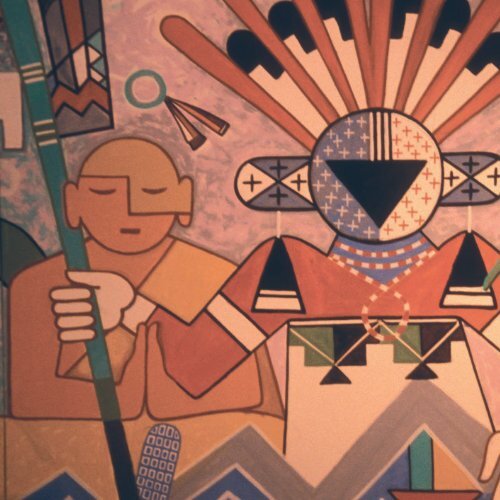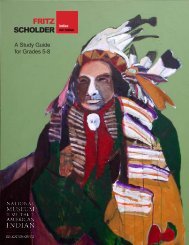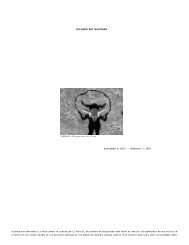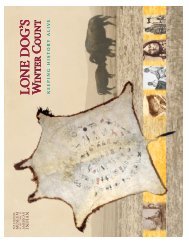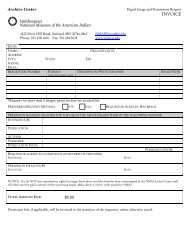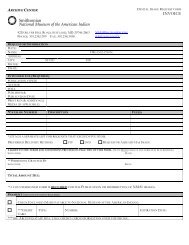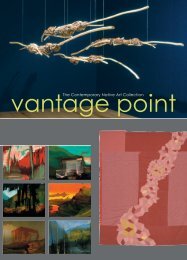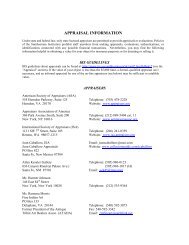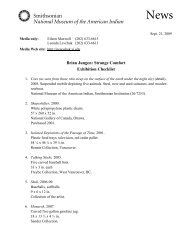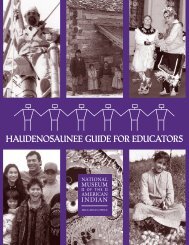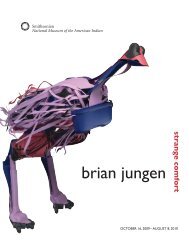Download the brochure (PDF) - National Museum of the American ...
Download the brochure (PDF) - National Museum of the American ...
Download the brochure (PDF) - National Museum of the American ...
- TAGS
- download
- brochure
- nmai.si.edu
You also want an ePaper? Increase the reach of your titles
YUMPU automatically turns print PDFs into web optimized ePapers that Google loves.
NATIVE ART IN THE AMERICAS<br />
NATIVE ARTISTS IN THE AMERICAS<br />
NATIONAL MUSEUM OF THE AMERICAN INDIAN NATIVE ARTS PROGRAM: THE FIRST TEN YEARS
NATIVE ARTISTS IN THE AMERICAS<br />
NATIONAL MUSEUM OF THE AMERICAN INDIAN NATIVE ARTS PROGRAM: THE FIRST TEN YEARS<br />
Introduction by Keevin Lewis. Essays and artwork by <strong>the</strong> artists.<br />
Edited by Jessica Welton.<br />
<strong>National</strong> <strong>Museum</strong> <strong>of</strong> <strong>the</strong> <strong>American</strong> Indian, Smithsonian Institution<br />
Washington, D.C., Suitland, Maryland, and New York
Text and images<br />
©<br />
2007, Smithsonian.<br />
Photography credits: pages 4 and 5, Maxwell MacKenzie; page 38, Ka<strong>the</strong>rine Fogden; page 78,<br />
Jessica Welton.<br />
All rights reserved. No part <strong>of</strong> this publication may be reproduced, stored in a retrieval system,<br />
or transmitted in any form or by any means, electronic, mechanical, photocopying, recording,<br />
or o<strong>the</strong>rwise, without written permission from <strong>the</strong> Smithsonian Institution and <strong>the</strong> <strong>National</strong><br />
<strong>Museum</strong> <strong>of</strong> <strong>the</strong> <strong>American</strong> Indian.<br />
Requests for permission to reproduce material from this work should be sent to: nap@si.edu<br />
For information about <strong>the</strong> Smithsonian <strong>National</strong> <strong>Museum</strong> <strong>of</strong> <strong>the</strong> <strong>American</strong> Indian, visit <strong>the</strong><br />
museum’s website at http://www.nmai.si.edu/
The <strong>National</strong><br />
<strong>Museum</strong> <strong>of</strong> <strong>the</strong><br />
<strong>American</strong> Indian<br />
is committed to<br />
advancing<br />
knowledge and<br />
understanding <strong>of</strong><br />
<strong>the</strong> Native cultures<br />
<strong>of</strong> <strong>the</strong> Western<br />
Hemisphere–past,<br />
present, and future–<br />
through partnership<br />
with Native<br />
peoples and o<strong>the</strong>rs.<br />
The museum<br />
works to support<br />
<strong>the</strong> continuance<br />
<strong>of</strong> culture,<br />
traditional values,<br />
and transitions<br />
in contemporary<br />
Native life.
TABLE OF CONTENTS<br />
Introduction............................................................................................4<br />
The History <strong>of</strong> <strong>the</strong> Native Arts Program..............................................8<br />
1996<br />
1999<br />
2000<br />
2001<br />
2002<br />
2003<br />
Glory Tacheenie-Campoy.........................................................14<br />
Bernice Akamine...........................................................................18<br />
Lisa Telford....................................................................................20<br />
Janet Marie Rogers............................ ...........................................24<br />
Evelyn Vanderhoop......................................................................26<br />
Margaret Roach Wheeler.............................................................28<br />
Star Wallowing Bull......................................................................32<br />
Jerry Ingram...................................................................................36<br />
Rebecca Lyon................................................................................38<br />
José Antonio Ancán Jara...............................................................42<br />
1
2004<br />
2005<br />
2006<br />
Barbara D. Francis.........................................................................44<br />
Teri R<strong>of</strong>kar......................................................................................46<br />
Umara Nupowhotuk/Buchea.....................................................50<br />
Oswaldo “Achu” Deleon Kantule...............................................52<br />
Benjamin Jacanamijoy Tisoy.......................................................54<br />
Heriberto Martinez Pioquinto.....................................................56<br />
Nadema Agard..............................................................................60<br />
Martha Gradolf.............................................................................62<br />
Jason Lujan....................................................................................64<br />
Jorge “Kaasip” Mashumbra Jimbicti...........................................66<br />
Kevin Pourier.................................................................................68<br />
Victoria Mitchell Vazquez............................................................70<br />
Johnny Bear Contreras..................................................................74<br />
Benjamin Jacanamijoy Tisoy........................................................76<br />
Michael Kabotie/Lomawywesa...................................................78<br />
Participating Artists..............................................................................80<br />
2
INTRODUCTION<br />
KEEVIN LEWIS, NAVAJO<br />
NMAI COMMUNITY AND CONSTITUENT SERVICES COORDINATOR<br />
The Native Arts<br />
Program has grown<br />
into its current<br />
state through<br />
discussion, feedback,<br />
and experience<br />
over ten years.<br />
4<br />
Following my arrival at <strong>the</strong> <strong>National</strong><br />
<strong>Museum</strong> <strong>of</strong> <strong>the</strong> <strong>American</strong> Indian (NMAI) in<br />
Washington, D.C., during <strong>the</strong> spring <strong>of</strong> 1995,<br />
I was tasked with defining, developing,<br />
and evaluating outreach programs that fit<br />
within <strong>the</strong> scope <strong>of</strong> what is now known as<br />
Community and Constituent Services.<br />
I used as resources <strong>the</strong> legislation <strong>of</strong> <strong>the</strong><br />
<strong>National</strong> <strong>Museum</strong> <strong>of</strong> <strong>the</strong> <strong>American</strong> Indian<br />
Act, <strong>the</strong> NMAI Mission Statement, and “The<br />
Way <strong>of</strong> <strong>the</strong> People,” a document created to<br />
give direction to <strong>the</strong> museum in its early<br />
years, but quickly determined that listening<br />
to <strong>the</strong> needs <strong>of</strong> Native people would be<br />
critical to accomplish my job’s goals. The<br />
NMAI Native Arts Program (NAP) was born<br />
<strong>of</strong> <strong>the</strong>se efforts, though it didn’t evolve<br />
overnight; it has grown into its current state
6<br />
through discussions, feedback, and experience<br />
over ten years. I can say with confidence<br />
that <strong>the</strong> NAP will always continue to evolve<br />
and mold itself to <strong>the</strong> ever-changing needs<br />
<strong>of</strong> Native artists.<br />
The Native Arts Program, which strives to be<br />
personally meaningful and culturally<br />
appropriate, was developed to address two<br />
key factors: First, <strong>the</strong> NAP is an opportunity<br />
to learn in many different ways. Seeing<br />
cultural materials in museum collections,<br />
working with youth in <strong>the</strong> community, and<br />
collaborating on symposia all add to a growing<br />
base <strong>of</strong> Indigenous cultural knowledge,<br />
art, history, and language. And, in each project,
this knowledge is meant to be shared with a<br />
larger audience via ga<strong>the</strong>rings, presentations,<br />
classroom instruction, <strong>the</strong> creation<br />
<strong>of</strong> new art, and high-tech outlets such as <strong>the</strong><br />
Internet. The second factor I believe to be<br />
significant is that <strong>the</strong> NAP works to change<br />
stereotypical images and ideas about Native<br />
artists and art. As you will see in <strong>the</strong>se pro-<br />
files, <strong>the</strong> artistic styles and genres are as vast<br />
and diverse as <strong>the</strong> artists <strong>the</strong>mselves.<br />
Native Artists in <strong>the</strong> Americas/<strong>National</strong><br />
<strong>Museum</strong> <strong>of</strong> <strong>the</strong> <strong>American</strong> Indian Native Arts<br />
Program: The First Ten Years, is a collection<br />
<strong>of</strong> NAP participant artwork partnered<br />
with personal thoughts, reflections, and<br />
reactions to <strong>the</strong> impact <strong>of</strong> <strong>the</strong> Native Arts<br />
Program on each <strong>of</strong> <strong>the</strong> artists’ lives. As<br />
<strong>of</strong> spring 2006, some 56 Native participants<br />
from seven countries throughout <strong>the</strong><br />
Western Hemisphere have completed <strong>the</strong><br />
program. This initial grouping <strong>of</strong> NAP<br />
participants is a first step toward <strong>the</strong> inclusion<br />
<strong>of</strong> all 56 participants from <strong>the</strong> first ten years.<br />
Through my experiences with <strong>the</strong> Native Arts<br />
Program and its artists, I have learned a<br />
greater respect and admiration for <strong>the</strong> diversity<br />
and strength <strong>of</strong> each individual artist. Each<br />
group <strong>of</strong> participants brings a different set <strong>of</strong><br />
interests, laughs, and experiences to <strong>the</strong><br />
program. We are <strong>of</strong>ten told by each artist that<br />
after <strong>the</strong>ir NAP experience <strong>the</strong>y are able to<br />
express and think about <strong>the</strong>ir work in new<br />
ways. From this, I see that art is a process–<br />
forever evolving into something different.<br />
I can say with<br />
confidence that <strong>the</strong><br />
NAP will always<br />
continue to evolve<br />
and mold itself<br />
to <strong>the</strong> ever-changing<br />
needs <strong>of</strong> Native<br />
artists.<br />
7
THE HISTORY OF THE NATIVE<br />
ARTS PROGRAM<br />
MOLLY McCRACKEN<br />
OUTREACH PROGRAM SPECIALIST<br />
The Native Arts<br />
Program has provided<br />
opportunities to<br />
some 56 artists from<br />
as far away as Chile,<br />
Hawaii, and Alaska.<br />
8<br />
The Native Arts Program has been serving<br />
Native <strong>American</strong> artists and communities<br />
since 1996 as an outreach initiative<br />
developed through Community and<br />
Constituent Services at <strong>the</strong> <strong>National</strong><br />
<strong>Museum</strong> <strong>of</strong> <strong>the</strong> <strong>American</strong> Indian. In its early<br />
stages, <strong>the</strong> program was called <strong>the</strong> Artist<br />
in Residence and was a collaborative effort<br />
between <strong>the</strong> <strong>National</strong> <strong>Museum</strong> <strong>of</strong> <strong>the</strong><br />
<strong>American</strong> Indian and Atlatl, <strong>National</strong><br />
Service Organization for Native <strong>American</strong><br />
Arts, based in Phoenix, Arizona. Original<br />
ideas for developing NMAI art programs<br />
grew from a 1995 Native <strong>American</strong> Arts<br />
policy development meeting, and included<br />
giving Native artists access to<br />
museum collections in order to enhance<br />
<strong>the</strong>ir artwork, developing collaborative
opportunities between those artists and<br />
museums, and creating a community<br />
connection through a follow-up project.<br />
As <strong>the</strong> program has grown and developed,<br />
several new opportunities have emerged<br />
that enhance <strong>the</strong> effectiveness <strong>of</strong> NMAI<br />
outreach endeavors, at <strong>the</strong> same time<br />
meeting <strong>the</strong> needs <strong>of</strong> Native artists <strong>of</strong> <strong>the</strong><br />
Western Hemisphere and Hawai’i. In 2002,<br />
<strong>the</strong> Native Arts Program opened its doors<br />
for <strong>the</strong> first time to <strong>the</strong> NMAI’s Latin<br />
<strong>American</strong> constituents by publishing <strong>the</strong><br />
Call for Proposals in Spanish. The Native<br />
Arts Program has provided opportunities to<br />
some 56 artists from as far away as Chile,<br />
Hawai’i, and Alaska whose artistic media<br />
are as diverse as basketry, painting, song,<br />
9
10<br />
and poetry. The Native Arts Program under-<br />
went ano<strong>the</strong>r phase <strong>of</strong> growth in 2003 by<br />
becoming more community-focused and<br />
engaging Native artists in conducting regional<br />
museum collection research, creating<br />
critical art dialogues for local symposia,<br />
and interacting with local Native youth<br />
groups in creating community murals.<br />
Community and Constituent Services also<br />
strives to document and make available<br />
<strong>the</strong>se experiences through recordings and<br />
Web pr<strong>of</strong>iles.<br />
Information on <strong>the</strong> Native Arts Program<br />
is available at www.<strong>American</strong>Indian.si.edu<br />
or via email at NAP@si.edu
Information on <strong>the</strong><br />
Native Arts Program<br />
is available at<br />
<strong>American</strong>Indian.si.edu<br />
or via email<br />
at NAP@si.edu<br />
11
996
GLORY TACHEENIE-CAMPOY<br />
NAVAJO<br />
ARIZONA, USA<br />
PAINTER, MIXEDMEDIA AND TEXTILE ARTIST<br />
VISITING ARTIST, 1996<br />
I drew my mo<strong>the</strong>r<br />
and my fa<strong>the</strong>r, our<br />
hogan, our horses,<br />
and our sheep;<br />
I drew <strong>the</strong> Storm<br />
Pattern rugs that<br />
my mo<strong>the</strong>r and<br />
aunt wove for <strong>the</strong><br />
trading post.<br />
14<br />
I grew up in a traditional family <strong>of</strong> artists,<br />
medicine men, handtremblers, crystal<br />
gazers, herbalists, and healers. The land<br />
was our source <strong>of</strong> survival. We planted corn<br />
and crops, raised horses, sheep, and goats,<br />
and traded with <strong>the</strong> Hopis and o<strong>the</strong>r Pueblo<br />
tribes. This was a positive experience for us.<br />
Our homes and shelters were built from<br />
local materials. Hogans, shade arbors,<br />
fences, corrals were all made by family and<br />
relatives helping each o<strong>the</strong>r.<br />
My mo<strong>the</strong>r taught me how to weave when<br />
I was about seven years old. Art was<br />
very much a part <strong>of</strong> our daily lives. Although<br />
no one in my family had a degree in art,<br />
we survived by making and producing art.<br />
I find that as an artist I am affected by <strong>the</strong><br />
contemporary social conditions <strong>of</strong> people<br />
in my community and <strong>the</strong> world. This<br />
residency has benefited both my work and<br />
my people.
Glory Tacheenie-Campoy, Three People on a Mesa, 2003. Acrylic on canvas, 49 x 37.5 in.<br />
15
999
BERNICE AKAMINE<br />
HAWAI’IAN<br />
HAWAII, USA<br />
MIXEDMEDIA, GLASS, AND FIBER ARTIST, PHOTOGRAPER<br />
VISITING ARTIST, 1999<br />
What can I as a<br />
Native artist hope to<br />
give to those who<br />
follow after me,<br />
but eyes that see<br />
and respect for<br />
one’s own and o<strong>the</strong>r<br />
cultures.<br />
18<br />
The Native Arts Program has done more<br />
than simply affect <strong>the</strong> process <strong>of</strong><br />
art-making. Attending NAP has heightened<br />
my awareness as a kanaka maoli Native<br />
person, while challenging me to continue in<br />
<strong>the</strong> pursuit <strong>of</strong> knowledge, knowing that a<br />
great debt is owed to <strong>the</strong> ancestors.<br />
Preservation <strong>of</strong> culture is paramount. Ra<strong>the</strong>r<br />
than regurgitating <strong>the</strong> past, it is important to<br />
produce contemporary artwork that<br />
rings true when focusing <strong>the</strong>matically on<br />
concepts, values, and mo’olelo (story or<br />
tradition) or that reflects <strong>the</strong> natural world<br />
<strong>of</strong> Hawai’i nei.<br />
There are two very different bodies <strong>of</strong><br />
artwork. One is a body <strong>of</strong> private emotions<br />
and thoughts, while <strong>the</strong> second looks at<br />
traditional and contemporary Hawaiian<br />
<strong>the</strong>mes. On occasion <strong>the</strong> two do merge with<br />
one ano<strong>the</strong>r. Within both bodies <strong>of</strong> art-<br />
work it is my aim to extract <strong>the</strong> essence or<br />
core elements, and to present <strong>the</strong>m in an<br />
abstract form, <strong>the</strong>reby eliciting a reaction or<br />
emotion within <strong>the</strong> viewer.
Bernice Akamine, O Laka, 2005. Glass, copper, and cloth covered wire, maile, lama, and palapalai.<br />
14 x 15 x 14 mm.<br />
19
LISA TELFORD<br />
HAIDA<br />
WASHINGTON, USA<br />
FIBER AND CEDAR BARK ARTIST<br />
VISITING ARTIST, 1999<br />
I will always be a<br />
spokeswoman<br />
for <strong>the</strong> Native Artist<br />
Program.<br />
It is an excellent<br />
opportunity for an<br />
artist’s career.<br />
20<br />
In <strong>the</strong> spring <strong>of</strong> 1998, I received an applica-<br />
tion for <strong>the</strong> Artist in Residence program<br />
from Atlatl. I read <strong>the</strong> application and felt it<br />
was meant for someone with more experi-<br />
ence. Questions regarding “artistic growth<br />
and development”–I wasn’t even sure what<br />
that was or how to begin to answer such<br />
questions. I didn’t have ten slides, who<br />
would write my letters <strong>of</strong> recommendation?<br />
Those were just a few <strong>of</strong> <strong>the</strong> thoughts that<br />
were running through my head.<br />
The waiting seemed like an eternity. On<br />
March 1st, 1999, I received a call from Keevin<br />
Lewis. My heart stopped as he said, “This is<br />
Keevin Lewis from <strong>the</strong> <strong>National</strong> <strong>Museum</strong> <strong>of</strong><br />
<strong>the</strong> <strong>American</strong> Indian.”Keevin told me that<br />
I had won. I burst into uncontrollable joyful<br />
tears. I was floating on cloud nine <strong>the</strong> rest <strong>of</strong><br />
<strong>the</strong> day. It felt like a dream.<br />
I saw, studied, and touched objects I never<br />
dreamt I would ever experience. I was<br />
inspired by <strong>the</strong> perfection and techniques<br />
<strong>of</strong> artists in <strong>the</strong> past. I will duplicate <strong>the</strong><br />
most beautiful cedar robe, <strong>the</strong> finest basket<br />
with false embroidery, and a headband no<br />
longer made today, among o<strong>the</strong>rs. I will<br />
always cherish <strong>the</strong> wonderful friendships I<br />
developed through <strong>the</strong> Native Arts Program.
Lisa Telford, Gladiator Dress, 2005. Pounded red cedar bark and abalone shells.<br />
21
000
JANET MARIE ROGERS<br />
TUSCARORA–SIX NATIONS<br />
BRITISH COLUMBIA, CANADA<br />
MULTIMEDIA ARTIST<br />
VISITING ARTIST, 2000<br />
In hindsight, I feel<br />
my evolution as an<br />
artist may be<br />
described as a writer<br />
who wrote with a<br />
brush and/or a<br />
painter who paints<br />
with a pen.<br />
24<br />
Participating in <strong>the</strong> Native Arts Program<br />
has definitely changed <strong>the</strong> way I process<br />
Native art as a viewer. Spending<br />
time amongst <strong>the</strong> collections has put a<br />
permanent stamp on me, making me<br />
consider past creations, contemporary<br />
creations, and <strong>the</strong> future <strong>of</strong> Native art all at<br />
once. Given <strong>the</strong> history between Native<br />
communities and museums, my overall view<br />
<strong>of</strong> museums was not a good one. However,<br />
through conversations with museum<br />
staff and exhibit curators, I have come to<br />
understand that <strong>the</strong> objects residing<br />
inside <strong>the</strong> institutions are very much cared<br />
for and protected for future generations.
Silver, stone treasures<br />
<strong>of</strong> many nations<br />
living toge<strong>the</strong>r on flat bed trays<br />
behind gates<br />
<strong>the</strong>y wait<br />
to be sorted<br />
segregated<br />
to be with <strong>the</strong>ir own<br />
and end <strong>the</strong> confusion <strong>of</strong> confiscation<br />
living in cramped quarters<br />
with unfamiliar cousins<br />
from far away places<br />
representing things that have nothing to do with one ano<strong>the</strong>r<br />
I listened – <strong>the</strong>y said<br />
We like to light up eyes<br />
be handled<br />
adored<br />
We crave human warmth<br />
To be brought into <strong>the</strong> light<br />
And visit with you<br />
I watch as <strong>the</strong>y wave<br />
tearful goodbyes<br />
pushed back into <strong>the</strong> dark<br />
becoming one <strong>of</strong> a hundred shelves<br />
lined up behind doors<br />
where visual treats<br />
rest<br />
Safe and ready<br />
To visit with you<br />
Janet Marie Rogers, Visit With You<br />
25
EVELYN VANDERHOOP<br />
HAIDA<br />
BRITISH COLUMBIA, CANADA<br />
TEXTILE, WOOL, AND CEDAR BARK ARTIST, WATERCOLOR PAINTER<br />
VISITING ARTIST, 2000<br />
The Beaver Apron<br />
was inspired by my<br />
being able to study<br />
old aprons at <strong>the</strong><br />
museums that were<br />
made available<br />
through <strong>the</strong> Native<br />
Arts Program.<br />
26<br />
There are only about twelve Native people<br />
who know <strong>the</strong> Chilkat weaving technique<br />
and only four Native women who have<br />
enough knowledge and experience to<br />
weave a robe. In <strong>the</strong> fall <strong>of</strong> this year I will<br />
have finished my first Chilkat robe. I plan on<br />
weaving Chilkat all my life. I want to<br />
weave as well as my ancestors and to share<br />
that tradition with <strong>the</strong> next generation <strong>of</strong><br />
weavers. I feel it is necessary to study <strong>the</strong>ir<br />
work. I would like to study in <strong>the</strong> New<br />
York museums as long as <strong>the</strong> grant allows.<br />
Chilkat weaving requires a great deal <strong>of</strong><br />
commitment. My first robe has taken one<br />
year and eight months to complete.
Evelyn Vanderhoop, Beaver Design Naxlin Apron, 2001–2006.<br />
Merino wool, beaver pelt, yellow cedar bark, deer hooves, width 37 in,<br />
27
MARGARET ROACH WHEELER<br />
CHICKASAW<br />
MISSOURI, USA<br />
FIBER SCULPTOR<br />
VISITING ARTIST, 2000<br />
To <strong>the</strong> early<br />
Native <strong>American</strong>s,<br />
<strong>the</strong> garments <strong>the</strong>y<br />
designed and wore<br />
were an extension<br />
<strong>of</strong> <strong>the</strong>ir thoughts and<br />
reflected <strong>the</strong>ir skills<br />
and tribal status.<br />
28<br />
I have had an innate belief in and<br />
commitment to <strong>the</strong> tradition and artwork<br />
<strong>of</strong> my ancestors. These traits have<br />
been reinforced by my participation in <strong>the</strong><br />
<strong>National</strong> <strong>Museum</strong> <strong>of</strong> <strong>the</strong> <strong>American</strong> Indian<br />
Native Arts Program. After completing my<br />
fellowship, I have been teaching workshops<br />
and seminars on ancient fibers <strong>of</strong> Native<br />
North America. Several presentations–<br />
Art <strong>of</strong> <strong>the</strong> Ancestors, Weaving a Legacy, and<br />
Adena Woman–come directly from my<br />
research on artifacts from <strong>the</strong> Spiro Mound<br />
during <strong>the</strong> NAP fellowship.<br />
Currently, I am working on A History<br />
<strong>of</strong> Native <strong>American</strong> Costumes, which is a<br />
fashion show featuring my handwoven<br />
garments. Many <strong>of</strong> <strong>the</strong> designs in this show<br />
are inspired by <strong>the</strong> costumes I photographed<br />
during my research at <strong>the</strong> NMAI Cultural<br />
Resources Center in Suitland, Maryland.<br />
I believe artistry and craftsmanship that can<br />
be observed in <strong>the</strong> NMAI collections <strong>of</strong><br />
Native <strong>American</strong> artifacts will inspire <strong>the</strong><br />
modern artist to achieve <strong>the</strong> highest<br />
standard in <strong>the</strong>ir own work and to carry on<br />
this proud heritage.
Margaret Roach Wheeler, The Messenger, 2005.<br />
Handwoven silk/wool Chief's robe and headdress with copper, shell, silver, and beads.<br />
29
001
STAR WALLOWING BULL<br />
OJIBWE-ARAPAHO<br />
NORTH DAKOTA, USA<br />
PAINTER<br />
VISITING ARTIST, 2001<br />
Participation in <strong>the</strong><br />
Native Arts Program<br />
gave me <strong>the</strong><br />
confidence to pursue<br />
art-making as my<br />
primary means <strong>of</strong><br />
earning an income.<br />
This helped me to<br />
build my self-esteem<br />
so much that artmaking<br />
became my<br />
means <strong>of</strong> staying<br />
sober and working<br />
toward building a<br />
meaningful life; without<br />
that boost,I don't<br />
think I would be<br />
where I am today.<br />
32<br />
I like to express my thoughts about my<br />
people’s history and politics through art.<br />
My work is not just about my people, but<br />
includes o<strong>the</strong>r tribes in this country:<br />
BLACK, WHITE, BROWN, and RED. I think<br />
that by dealing with <strong>the</strong>se historical and<br />
political issues in my art, I can help people<br />
understand how o<strong>the</strong>r people feel.<br />
With my work today, I like to look at<br />
historical pictures and draw from <strong>the</strong>m.<br />
I like to read about history, and <strong>the</strong>n an<br />
idea will come to me for a drawing. That’s a<br />
major source for my work. I don’t want to<br />
make <strong>the</strong> pictures realistic, but to<br />
make <strong>the</strong>m different than what <strong>the</strong>y are–<br />
to abstract <strong>the</strong>m.
Star Wallowing Bull, The Three Bears, 2006. Colored pencil on paper, 30 x 22.25 in.<br />
33
002
JERRY INGRAM<br />
CHOCTAW<br />
NEW MEXICO, USA<br />
BEADWORK AND QUILLWORK ARTIST<br />
VISITIG ARTIST, 2002<br />
The Native Arts<br />
Program has<br />
educated me in<br />
many things besides<br />
<strong>the</strong> traditional<br />
clothing, beadwork,<br />
and quillwork <strong>of</strong> my<br />
focus tribes. It has<br />
taught me about <strong>the</strong><br />
management <strong>of</strong><br />
collections, how to<br />
get access for<br />
fur<strong>the</strong>r museum<br />
research, and how to<br />
deal with <strong>the</strong><br />
logistics <strong>of</strong> traveling<br />
in <strong>the</strong> urban areas <strong>of</strong><br />
<strong>the</strong> East Coast.<br />
36<br />
Since participating in <strong>the</strong> NMAI Native Arts<br />
Program I have increased my search for cultural<br />
materials appropriate to <strong>the</strong> era I am<br />
attempting to represent. I have also been able<br />
to apply old sewing techniques that I<br />
learned from my visits to museum collections.<br />
The NMAI Native Arts Program spurred me<br />
to share my knowledge with <strong>the</strong> students <strong>of</strong><br />
<strong>the</strong> Institute <strong>of</strong> <strong>American</strong> Indian Arts in<br />
Santa Fe, New Mexico, where I have taught a<br />
Traditional Techniques Clothing class for<br />
several years. It is rewarding to watch <strong>the</strong><br />
students grow and create using <strong>the</strong>ir own<br />
backgrounds, talents, and techniques<br />
learned in class. I am glad to provide inspi-<br />
ration and instruction to young artists.
Jerry Ingram, Lakota Style Moccasins, 2006. Brain-tanned<br />
smoked buckskin, glass beads, thread.<br />
37
REBECCA LYON<br />
ATHABASCAN-ALEUT<br />
ALASKA, USA<br />
SCULPTOR, MIXEDMEDIA ARTIST<br />
VISITING ARTIST, 2002<br />
Even though I wear<br />
Gap jeans and<br />
live a nontraditional<br />
lifestyle, I have<br />
found I wear<br />
traditional clothing<br />
on <strong>the</strong> inside.<br />
38<br />
As I have looked back to make a connection<br />
with <strong>the</strong> past generations <strong>of</strong> women in my<br />
family and culture, I lament that no personal<br />
artifact or mementos from my great-grand-<br />
mo<strong>the</strong>rs or <strong>the</strong> women before <strong>the</strong>m have been<br />
passed down in my family. I have found myself<br />
searching though museum collections and<br />
anthropology books studying <strong>the</strong> clinical spec-<br />
imens <strong>of</strong> clothing attributed to my Athabascan<br />
ancestors, trying to make this connection.<br />
During a visit to a museum, I stood for a long<br />
time in front <strong>of</strong> a diorama depicting an<br />
Athabascan village. I carefully studied a beau-<br />
tiful woman’s moose hide dress draped over a<br />
plaster mannequin, and a great sadness over-<br />
came me. I realized that what I was doing was<br />
very much like visiting a loved one’s grave, as<br />
if <strong>the</strong> dress held <strong>the</strong><br />
spirit <strong>of</strong> all those<br />
women who had<br />
come before me.<br />
It was <strong>the</strong>n that I<br />
decided to recreate <strong>the</strong> clothing <strong>of</strong> women<br />
from four <strong>of</strong> Alaska’s Native cultures in copper.<br />
The clothing we wear identifies and holds<br />
<strong>the</strong> human spirit. I have created <strong>the</strong>se<br />
dresses to represent a ga<strong>the</strong>ring <strong>of</strong> women’s<br />
spirits housed inside <strong>the</strong> most feminine <strong>of</strong><br />
metals–copper. The use <strong>of</strong> nontraditional<br />
materials moves <strong>the</strong> visual dialogue into<br />
<strong>the</strong> present. This is my way <strong>of</strong> honoring <strong>the</strong><br />
women <strong>of</strong> <strong>the</strong> North for <strong>the</strong>ir ability to<br />
survive natural and cultural adversity and<br />
for <strong>the</strong>ir artistry.
Rebecca Lyon, Tlingit/Haida Woman, 2004. Copper, shell buttons, and patinas, 40.5 x 70 x 8 in.<br />
39
003
JOSE ´ ANTONIO ANCAN ´<br />
JARA<br />
MAPUCHE<br />
REGIÓN DE LA ARAUCANÍA, CHILE<br />
SCULPTOR, WRITER<br />
VISITING ARTIST, 2003<br />
My proposal is based<br />
on <strong>the</strong> analysis <strong>of</strong><br />
ethnographic<br />
materials from <strong>the</strong><br />
Mapuche community<br />
held in existing<br />
museum collections.<br />
Since that material is<br />
virtually unknown<br />
in its original context,<br />
simply recognizing<br />
it creates a significant<br />
advance in increasing<br />
<strong>the</strong> value and<br />
promotion <strong>of</strong><br />
Mapuche culture.<br />
42<br />
Contained in <strong>the</strong> extensive bibliography on<br />
<strong>the</strong> Mapuche people is a valuable set <strong>of</strong><br />
photographs <strong>of</strong> Native people from different<br />
communities who were taken prisoner<br />
by Argentinean soldiers at <strong>the</strong> end <strong>of</strong><br />
<strong>the</strong> 19th century. Standing out among <strong>the</strong>se<br />
images are several <strong>of</strong> Saiweke, <strong>the</strong> last<br />
Mapuche community leader to lay down<br />
his arms. His life was extensively docu-<br />
mented by <strong>the</strong> many travelers who met him,<br />
but I find it curious that <strong>the</strong>re are no repre-<br />
sentations <strong>of</strong> him or <strong>of</strong> any o<strong>the</strong>r Mapuche<br />
protagonists prior to <strong>the</strong>ir imprisonment.<br />
My Native Arts Program research was based<br />
on <strong>the</strong> review and analysis <strong>of</strong> museum<br />
and ethnographic data from <strong>the</strong> Mapuche<br />
community in collections from <strong>the</strong> several<br />
museums I visited. Since that material is<br />
virtually unknown in its original context,<br />
simply seeing and recognizing it creates a<br />
significant advance in increasing <strong>the</strong> value<br />
and promotion <strong>of</strong> Mapuche culture.<br />
The article I include here draws on <strong>the</strong><br />
results <strong>of</strong> my Native Arts Program research.<br />
The first Biennale <strong>of</strong> Indigenous Art and<br />
Culture in Santiago, Chile (January 2006),<br />
showcased <strong>the</strong> work <strong>of</strong> <strong>the</strong> foremost<br />
Mapuche engraver and artist, Santos Chávez<br />
(1934-2001). Using Santos Chávez’s legacy<br />
as a departing point, <strong>the</strong> article conducts a<br />
critical reflection <strong>of</strong> <strong>the</strong> responsibilities<br />
I believe that contemporary indigenous<br />
artists have today.
GRABADOS DE SANTOS CHAVEZ:<br />
REENCUENTRO DESDE LA TIERRA QUE<br />
ESTA AL OTRO LADO DEL MAR<br />
“Yo soy una partícula en el cosmos,<br />
¿Qué somos en el sistema planetario,<br />
en el espacio infinito?. . . El equilibrio,<br />
la armonía, el sentido, el simbolismo, la<br />
poesía. . . es toda mi vida de niño, solo<br />
en el campo, el mundo que interpreto<br />
en mi obra. A lo lejos sale una ventana<br />
por ahí [ . . . ] no puedo decir "lo sé todo,"<br />
así que sigo trabajando, sufriendo y<br />
buscando para hallar ese no sé qué que<br />
uno busca. . . .” (Santos Chávez)<br />
En más de una oportunidad, en particular<br />
en sus últimos años antes de viajar<br />
a la Tierra al Otro lado del Mar, se le<br />
escucharon decir a Santos Chávez palabras<br />
como estas.<br />
For <strong>the</strong> rest <strong>of</strong> <strong>the</strong> essay in Spanish, click here.<br />
On more than one occasion, particularly<br />
in his final years before making <strong>the</strong><br />
trip to <strong>the</strong> Land on <strong>the</strong> O<strong>the</strong>r Side <strong>of</strong> <strong>the</strong><br />
Sea, Santos Chávez was heard to say<br />
words like <strong>the</strong>se.<br />
For <strong>the</strong> rest <strong>of</strong> <strong>the</strong> English translation, click here.<br />
José Antonio Ancán Jara, 2005.<br />
43
BARBARA D. FRANCIS<br />
PENOBSCOT<br />
MAINE, USA<br />
BROWN ASH BASKETMAKER<br />
VISITING ARTIST, 2003<br />
It is not enough to<br />
know technique and<br />
materials, it is to<br />
touch <strong>the</strong> brown ash<br />
and realize <strong>the</strong> gift<br />
<strong>of</strong> possibility within<br />
<strong>the</strong> tree itself.<br />
44<br />
Once <strong>the</strong> rhythmic pounding begins<br />
to loosen <strong>the</strong> growth rings (<strong>of</strong> <strong>the</strong> chosen<br />
brown ash tree) my imagination starts<br />
seeing baskets. They come to me in my<br />
dreams and <strong>of</strong>ten when I am doing chores<br />
unrelated to basketry. I will sketch <strong>the</strong>m and<br />
once I pick up my materials, my hands<br />
know exactly what <strong>the</strong>y are supposed to do.<br />
An extension <strong>of</strong> myself reaches back into<br />
<strong>the</strong> time <strong>of</strong> my ancient ones, and I become<br />
part <strong>of</strong> <strong>the</strong> life that has flowed through my<br />
ancestors since <strong>the</strong>ir beginning.
Barbara Daigle Francis, Penobscot Curly Bowl, 2006. Brown ash bound with loose sweetgrass,<br />
diameter 5.5 in.<br />
45
TERI ROFKAR<br />
TLINGIT<br />
ALASKA, USA<br />
BASKETMAKER, RAVEN’S TAIL WEAVER<br />
VISITING ARTIST, 2003<br />
While I weave<br />
in an ancient<br />
traditional<br />
technique, I<br />
am alive<br />
and engaged<br />
in today’s<br />
contemporary<br />
world.<br />
46<br />
I was introduced to Tlingit weaving as a<br />
child, but it wasn’t until <strong>the</strong> mid-1980s that I<br />
made a commitment to become <strong>the</strong> best<br />
basket-weaver I could. I was fortunate. My<br />
journey took me into <strong>the</strong> backrooms <strong>of</strong> <strong>the</strong><br />
Smithsonian, <strong>American</strong> Natural History,<br />
University <strong>of</strong> Pennsylvania, Metropolitan, and<br />
Brooklyn museums as a Visiting Artist in 2003.<br />
It was an awakening! I still look at my notes<br />
and refer to my photos–<strong>the</strong>y contain so many<br />
inspiring ideas just waiting to be woven.<br />
When I visit artifacts, it is as if I am visiting<br />
old friends; <strong>the</strong>y challenge me always! But<br />
I am able to experience <strong>the</strong> life <strong>the</strong>se pieces<br />
hold today–humor and visual trickery,<br />
heavy use, and even sorrow. I was looking at<br />
old baskets in one museum on <strong>the</strong> East<br />
Coast, thinking <strong>of</strong> <strong>the</strong> time and place <strong>the</strong>y<br />
were collected. The design and style <strong>of</strong><br />
weaving give <strong>the</strong>m a high probability <strong>of</strong><br />
being my grandmo<strong>the</strong>rs’ and great-grand-<br />
mo<strong>the</strong>rs’ baskets. These baskets don’t<br />
speak only <strong>of</strong> <strong>the</strong> past, but reflect an intimate<br />
relationship between today, tomorrow,<br />
and yesterday. It is up to me to add my<br />
voice, a song for <strong>the</strong> future. Not over <strong>the</strong><br />
s<strong>of</strong>t voices <strong>of</strong> <strong>the</strong> past, but in harmony, as<br />
a chorus becomes strong with new life.
Teri R<strong>of</strong>kar, Earthquake, 2004. Tlingit Raven's Tail weaving, wool with sea otter trim, ca. 72 x 54 in.<br />
47
004
UMARA NUPOWHOTUK/BUCHEA<br />
SIBERIAN YUPIK AND INUPIAQ<br />
ALASKA, USA<br />
HIDE AND FUR ARTIST<br />
VISITING ARTIST, 2004<br />
After my research at<br />
<strong>the</strong> Smithsonian,<br />
my dreams became<br />
more vivid and<br />
I began to better<br />
understand what my<br />
grandmo<strong>the</strong>r had<br />
been trying to tell me<br />
for years.<br />
50<br />
The elderly women encouraged me to touch<br />
<strong>the</strong>ir tattooed faces so that I could feel <strong>the</strong><br />
designs, but now all <strong>of</strong> <strong>the</strong>m have passed<br />
away. I create <strong>the</strong> masks because I want<br />
future generations to remember <strong>the</strong> tattoos,<br />
to remember <strong>the</strong>se traditions.<br />
The beads on my masks have special<br />
meaning for me. In my first memory <strong>of</strong> my<br />
childhood, I remember wearing beads all<br />
over my body, around my neck, waist, arms,<br />
wrists, thighs, and ankles. My grandparents<br />
were old and had taken me, as <strong>the</strong>ir first-<br />
born grandchild, to renew <strong>the</strong>ir youth. Their<br />
only daughter had passed away, and I am<br />
her namesake. My grandparents gave me all<br />
<strong>of</strong> her beads that were not buried with her.<br />
Beads have significance in our culture and<br />
were used by <strong>the</strong> shamans. If a shaman put<br />
a bead on <strong>the</strong> seat <strong>of</strong> a boat captain, he<br />
would fall ill. When someone was sick, a<br />
shaman could put <strong>the</strong>ir sickness into <strong>the</strong> hole<br />
in <strong>the</strong> center <strong>of</strong> a bead and it would be buried.<br />
I sincerely hope that <strong>the</strong> Smithsonian will<br />
maintain <strong>the</strong> collection <strong>of</strong> artifacts so that<br />
<strong>the</strong> future generations <strong>of</strong> artists can share in<br />
my experience. I would prefer that all <strong>of</strong> <strong>the</strong><br />
artifacts remain in one central place so that<br />
my grandchildren and great-grandchildren<br />
can go and see <strong>the</strong>m. Every generation’s art is<br />
unique and should be cherished and preserved.
Umara Nupowhotuk/Buchea, Annie, 2003. Bleached caribou hide, fur, and beads, 14 x 12 in.<br />
51
OSWALDO “ACHU” DELEON KANTULE<br />
KUNA<br />
CIUDAD DE PANAMÁ, PANAMA<br />
PAINTER<br />
VISITING ARTIST, 2004<br />
I have learned that<br />
my ancestors<br />
expressed <strong>the</strong>ir way<br />
<strong>of</strong> seeing <strong>the</strong><br />
world, <strong>the</strong>ir fears and<br />
frustrations in <strong>the</strong><br />
molas, sculptures,<br />
and drawings.<br />
52<br />
After my participation in <strong>the</strong> Native Arts<br />
Program, I believe that <strong>the</strong>re are important<br />
differences in <strong>the</strong> creation <strong>of</strong> my works.<br />
Now, before beginning a piece, I take more<br />
care in choosing <strong>the</strong> elements that I consider<br />
using, without copying <strong>the</strong>m exactly.<br />
I believe my works to have become more<br />
spiritual and deep.<br />
Since my participation in <strong>the</strong> program,<br />
I can say as an individual that I have more<br />
concrete arguments supporting <strong>the</strong> validity<br />
<strong>of</strong> my work. It now clearly reflects <strong>the</strong><br />
philosophy and values <strong>of</strong> my culture as well<br />
as my values as an individual.
Oswaldo “Achu” Deleon Kantule, Espiritus del Galu, 2006. Acrylic on canvas, 40 x 30 in.<br />
53
BENJAMIN JACANAMIJOY TISOY<br />
PUEBLO INGA DEL VALLE DE SIBUNDOY<br />
BOGATA D.C., COLOMBIA<br />
PAINTER<br />
VISITING ARTIST, 2004<br />
My work as an<br />
artist and researcher<br />
has allowed<br />
me to point out <strong>the</strong><br />
relationship<br />
between <strong>the</strong> art <strong>of</strong><br />
weaving and <strong>the</strong> art<br />
<strong>of</strong> living through<br />
<strong>the</strong> chumbe symbols<br />
and to tell stories<br />
in a specific place <strong>of</strong><br />
life and thought.<br />
54<br />
I believe that <strong>the</strong> NMAI’s Native Arts<br />
Program stimulates Indigenous artists in<br />
every respect. My participation in this<br />
program has been inspirational for artists<br />
from my community as well as for artists<br />
from all across Colombia.<br />
Through <strong>the</strong> Visiting Artist fellowship, I was<br />
able to visit organizations such as <strong>the</strong><br />
Hemispheric Institute <strong>of</strong> Performance and<br />
Politics <strong>of</strong> New York University, which in<br />
turn allowed me to meet o<strong>the</strong>r artists.<br />
At home, I was able to create a more formal<br />
connection with <strong>the</strong> children, youth, and<br />
elders <strong>of</strong> my community through <strong>the</strong> devel-<br />
opment <strong>of</strong> <strong>the</strong> Youth Mural Project.<br />
Within this framework, I can confirm that <strong>the</strong><br />
support received from <strong>the</strong> program in<br />
validating my work as an artist is very signif-<br />
icant. NMAI has revalidated my determination<br />
to continue researching and weaving <strong>the</strong><br />
thread <strong>of</strong> tradition through both my painting<br />
and writing.
Benjamin Jacanamijoy, Lugar de sol, frió y sangre, 2005. Acrylic on linen, 78.75 x 71 in.<br />
55
HERIBERTO MARTÍNEZ PIOQUINTO<br />
PUEBLO MIXE<br />
SANTA MARIA ALOTEPEC MIXE PUEBLO, OAXACA, MEXICO<br />
PAINTER<br />
YOUTH MURAL PROJECT, 2004<br />
I work to reflect<br />
my values in my art<br />
as well as my<br />
Mixe culture from<br />
Alotepec and<br />
o<strong>the</strong>r communities<br />
in Oaxaca, Mexico.<br />
56<br />
The Native Arts Program has changed <strong>the</strong><br />
way I create art. Before this project <strong>the</strong> people<br />
in my town didn’t recognize me as a painter.<br />
Now <strong>the</strong> community realizes that through<br />
<strong>the</strong> Youth Mural Project I was able to show-<br />
case <strong>the</strong> history <strong>of</strong> our village. The people<br />
<strong>of</strong> surrounding communities are pleased<br />
with <strong>the</strong> mural as well. Perhaps <strong>the</strong> most<br />
interesting result was that when I began<br />
work on <strong>the</strong> mural, <strong>the</strong> local musicians and<br />
municipal authority were in conflict,<br />
but through <strong>the</strong> painting <strong>the</strong>y united and<br />
worked toge<strong>the</strong>r for <strong>the</strong> good <strong>of</strong> <strong>the</strong><br />
community. It was also exciting that only<br />
five months later I was contracted to paint<br />
ano<strong>the</strong>r mural in <strong>the</strong> Municipal Palace.<br />
For me, art is important because it forms<br />
part <strong>of</strong> my being, part <strong>of</strong> my life, and part <strong>of</strong><br />
my people. As a human being I believe that<br />
one day I will go to <strong>the</strong> beyond. I don’t know<br />
where I will go, but my art will remain.
Heriberto Martinez Pioquinto, xuxpë woojpë, jiawën ja napookmëtë, ayuuk kä'äjpn<br />
(Music: Soul <strong>of</strong> <strong>the</strong> Ayuuk people <strong>of</strong> Alotepec), 2004. 9 x 4 m.<br />
57
005
NADEMA AGARD<br />
CHEROKEE/LAKOTA/POWHATAN<br />
NEW YORK, USA<br />
PAINTER<br />
COMMUNITY ARTS SYMPOSIUM, 2005<br />
Before European<br />
portraits were<br />
introduced to Native<br />
<strong>American</strong>s, we<br />
portrayed ourselves<br />
not as specific<br />
individuals, but as<br />
tribal members.<br />
I feel that <strong>the</strong> Native<br />
Arts Program<br />
has reclaimed that<br />
sense <strong>of</strong> community<br />
on a hemispheric<br />
level.<br />
60<br />
Since I have participated in this program, I<br />
have made art not just as a personal<br />
expression, but also as a spiritual and cultur-<br />
al statement. Being part <strong>of</strong> <strong>the</strong> program has<br />
given me a great sense <strong>of</strong> personal accom-<br />
plishment, but it has also been a vehicle<br />
in which I have been able to give opportu-<br />
nities to o<strong>the</strong>r Native artists. That is what<br />
it is all about for me as a Native person–<br />
that we belong and take care <strong>of</strong> each o<strong>the</strong>r,<br />
because one person’s success benefits <strong>the</strong><br />
whole community or nation.<br />
Being one among many accomplished<br />
artists in this program has given me a sense<br />
<strong>of</strong> community that is <strong>of</strong> great importance in<br />
<strong>the</strong> Native world and particularly for <strong>the</strong><br />
Lakota. We call it tiospaye, or extended family.<br />
My recent<br />
works have<br />
incorporated<br />
my emphasis<br />
on New York<br />
iconography<br />
with respect to<br />
an Algonquin<br />
presence and<br />
my Lakota warrior woman spirit. It is very<br />
specific to New York, but with a deep tradi-<br />
tional and spiritual motive. Although<br />
changed, it still incorporates a larger, more<br />
cosmic agenda. It also seeks to include a<br />
cosmopolitan environment within <strong>the</strong> circle<br />
<strong>of</strong> Indigenous aes<strong>the</strong>tics, putting it on <strong>the</strong><br />
cutting edge, with spiritual borders crossing<br />
and cross-cultural dialoguing.
Nadema Agard, Warrior Woman Stance, 1997-2005. Pastel and digital image, 23 x 29 in.<br />
61
MARTHA GRADOLF<br />
WINNEBAGO OF NEBRASKA<br />
INDIANA, USA<br />
WEAVER<br />
VISITING ARTIST, 2005<br />
I weave <strong>the</strong> beauty<br />
and truth <strong>of</strong> our<br />
many cultures into<br />
webs and I weave<br />
to make my family<br />
proud.<br />
62<br />
The Native Arts Program had a big impact<br />
on me. Having <strong>the</strong> opportunity to view and<br />
study so many fine examples <strong>of</strong> Winnebago<br />
textiles in <strong>the</strong> various museum collections<br />
was an experience that could not have been<br />
accomplished without going through <strong>the</strong><br />
NAP program. Holding <strong>the</strong> bags and examin-<br />
ing <strong>the</strong> weave structures was a literal view<br />
into <strong>the</strong> past. Thinking <strong>of</strong> <strong>the</strong> people who<br />
created <strong>the</strong> bags, <strong>the</strong>ir families, <strong>the</strong>ir day-to-<br />
day lives, and how <strong>the</strong> bags were used was<br />
a tangible connection to my ancestors.<br />
Primarily, I am a contemporary artist<br />
weaving nontraditional items. I had not<br />
thought <strong>of</strong> weaving traditional utilitarian<br />
objects until going through <strong>the</strong> Native Arts<br />
Program. I have added twining and<br />
Thunderbird designs on some <strong>of</strong> my<br />
recent weavings. These are techniques and<br />
designs <strong>of</strong> <strong>the</strong> Woodland bags that I<br />
researched and studied. I will continue to<br />
incorporate <strong>the</strong> traditional weave structure<br />
and designs, colors, and fibers into my<br />
contemporary weavings. This will keep <strong>the</strong><br />
traditional style alive as it moves into a<br />
contemporary form. And in <strong>the</strong> not-so-<br />
distant future, I hope to add <strong>the</strong> traditional<br />
Woodland bags to my weaving repertoire.
Martha Gradolf, A Little Bling for <strong>the</strong> Chiefs, 2006. Wool, copper, nickel spots, Swarovski crystals,<br />
paper, and poly ribbon, 16 x 36 in. with 7 in. fringe.<br />
63
JASON LUJAN<br />
CHIRICAHUA APACHE<br />
NEW YORK, USA<br />
CONCEPTUAL ARTIST<br />
VISITING ARTIST, 2005<br />
My art serves a<br />
means to both<br />
control and release<br />
my identity as an<br />
Indian. It’s not so<br />
much a reflection <strong>of</strong><br />
cultural values as<br />
a narrative <strong>of</strong> how<br />
and what Native<br />
culture could look<br />
like once it escapes<br />
<strong>the</strong> boundaries<br />
<strong>of</strong> traditionalism and<br />
parochialism.<br />
64<br />
My participation with <strong>the</strong> NAP allowed me<br />
to experience indigenous material pasts<br />
within contemporary contexts. I handled<br />
ancient objects and considered <strong>the</strong>m not<br />
for <strong>the</strong>ir original virtues, but for what<br />
purpose <strong>the</strong>y served now. The comparisons<br />
between <strong>the</strong> objects and myself, as a<br />
person (with all that <strong>the</strong> term <strong>American</strong><br />
Indian implies), has intensified my desire to<br />
create, create, create.<br />
I want to produce a body <strong>of</strong> work that<br />
reminds <strong>the</strong> audience that Native objects<br />
seen and presented in museums are being<br />
presented outside <strong>of</strong> <strong>the</strong>ir original context.<br />
In <strong>the</strong> museum environment Native objects<br />
are disconnected from <strong>the</strong>ir makers’ original<br />
intent. Generally, museum audiences tend<br />
to view cultural objects within <strong>the</strong> frame-<br />
work <strong>of</strong> <strong>the</strong> institution, in a rarified status<br />
that becomes perceived as being <strong>the</strong>ir natural<br />
state. I want to illustrate <strong>the</strong> impossibility<br />
<strong>of</strong> speaking au<strong>the</strong>ntically about <strong>the</strong> Indian<br />
experience in this environment.
Jason Lujan, Peripheral Actions, 2005. Installation.<br />
65
JORGE “KAASIP”MASHUMBRA JIMBICTI<br />
SHUAR<br />
PROVINCIA DE PASTAZA, ECUADOR<br />
MUSICIAN<br />
VISITING ARTIST, 2005<br />
After my experience<br />
with <strong>the</strong> Native Arts<br />
Program, I value<br />
even more my music<br />
and dance.<br />
66<br />
I am proud <strong>of</strong> <strong>the</strong> youths from different<br />
communities within my Shuar pueblo<br />
who have not lost <strong>the</strong> value and richness <strong>of</strong><br />
<strong>the</strong> culture <strong>of</strong> <strong>the</strong> rainforest. I feel an<br />
Indigenous pride because, in <strong>the</strong> different<br />
museums that I visited, <strong>the</strong> materials and<br />
values <strong>of</strong> my pueblo exist, and among o<strong>the</strong>r<br />
Indigenous cultures <strong>of</strong> <strong>the</strong> world, it is <strong>the</strong><br />
Shuar culture that stands out.<br />
As an Indigenous musician from <strong>the</strong><br />
Amazonian rainforest, I have noticed that<br />
my art has progressed into ano<strong>the</strong>r style <strong>of</strong><br />
tones and has begun to fuse classical<br />
rhythms from my Shuar pueblo with current<br />
rhythms from <strong>the</strong> Western world. This has<br />
been accomplished without losing <strong>the</strong><br />
originality <strong>of</strong> Shuar music. I achieved this<br />
variation after having been a fellow in <strong>the</strong><br />
Native Arts Program at NMAI in 2005.
To hear a sample <strong>of</strong> Jorge’s music, click here.<br />
Jivaros–The Headshrinkers, 2005. Four songs sung in <strong>the</strong> Shuar language and fused with<br />
different Shuar and Western instruments, two <strong>of</strong> which are ancestral ritual songs and one <strong>of</strong><br />
which is in Spanish. All <strong>of</strong> <strong>the</strong> songs were inspired by <strong>the</strong> Amazon rainforest.<br />
67
KEVIN POURIER<br />
OGLALA LAKOTA<br />
SOUTH DAKOTA, USA<br />
BUFFALO HORN ARTIST<br />
VISITING ARTIST, 2005<br />
When I started<br />
making buffalo horn<br />
items, I was beginning<br />
a journey that<br />
would lead me to<br />
finding out many<br />
things about myself,<br />
my Lakota people<br />
and lifeways that<br />
would influence my<br />
life in a great way.<br />
68<br />
My participation in <strong>the</strong> NMAI Fellowship<br />
program introduced me to several new<br />
ideas on how things were made with buffalo<br />
horn. The horn cups I recently started to<br />
make and <strong>the</strong> small buffalo horn spoons<br />
that each individual owned, I have begun<br />
making those also. Being able to hold<br />
and examine things that were made by my<br />
relatives had a dramatic effect on my<br />
understanding <strong>of</strong> what this material really<br />
meant to <strong>the</strong> Lakotas. I saw <strong>the</strong> care and<br />
hard work that went into making objects<br />
created out <strong>of</strong> love for each o<strong>the</strong>r. I had<br />
always known how things were made to be<br />
given away, but to see <strong>the</strong>m firsthand and<br />
realize that <strong>the</strong>y are as beautiful as any<br />
art made today made me realize just how<br />
wonderful our lifeways really are.
Kevin Pourier, Swallowtail Horn Cup, 2006. Buffalo horn, length 16 in.<br />
69
VICTORIA MITCHELL VAZQUEZ<br />
CHEROKEE<br />
OKLAHOMA, USA<br />
POTTER<br />
VISITING ARTIST, 2005<br />
The basic difference<br />
I see in <strong>the</strong> way I<br />
create my pottery<br />
now, as opposed to<br />
before my participation,<br />
is that I think<br />
more carefully about<br />
why I want to make<br />
a certain piece, what<br />
my pottery will<br />
represent in my<br />
thinking, and what I<br />
wish <strong>the</strong> viewer to<br />
see in my work.<br />
70<br />
I feel so connected to those who went<br />
before me, wondering what <strong>the</strong>y were<br />
thinking about as <strong>the</strong>y worked, if <strong>the</strong>y were<br />
women or men, if <strong>the</strong>y visited with o<strong>the</strong>rs<br />
as <strong>the</strong>y worked or, like me, worked alone in<br />
a special place. I require more solitude now<br />
when I am working and find that <strong>the</strong><br />
music I previously listened to while working<br />
seems almost like an intrusion.<br />
The fact that so many artisans before me<br />
created not only utilitarian vessels, but also<br />
artistic expressions <strong>of</strong> things in nature–<br />
plant life, animal and human effigies, some<br />
reflecting humor, individuality, and a high<br />
level <strong>of</strong> skill–was amazing. My appreciation<br />
has elevated for what my ancestors created<br />
without <strong>the</strong> use <strong>of</strong> modern tools, alternative<br />
methods <strong>of</strong> firing, and <strong>the</strong> fact <strong>the</strong> pottery<br />
from thousands <strong>of</strong> years ago is still intact.<br />
It is a very special look into <strong>the</strong> past that so<br />
few <strong>of</strong> us are honored to see.
Victoria Maurine Mitchell Vazquez, Mo<strong>the</strong>r and Child–Nativity, 2005. Native Oklahoma clay, height 7 in.<br />
71
006
JOHNNY BEAR CONTRERAS<br />
SAN PASQUAL BAND OF KUMEYAAY<br />
CALIFORNIA, USA<br />
SCULPTOR<br />
VISITING ARTIST, 2006<br />
I feel we should be<br />
able to use our past,<br />
traditional values<br />
and recognize ways<br />
to adapt <strong>the</strong>mes<br />
into a contemporary<br />
lifestyle without<br />
being too left-field or<br />
out <strong>of</strong> touch with<br />
convention.<br />
74<br />
The time I spent at <strong>the</strong> <strong>National</strong> <strong>Museum</strong> <strong>of</strong><br />
<strong>the</strong> <strong>American</strong> Indian in Washington, D.C., and<br />
in some <strong>of</strong> <strong>the</strong> most prestigious archives in<br />
New York, Boston, and Philadelphia became<br />
a turning point in my career. The memo-<br />
rable people I met will continue to enrich<br />
my life as relationships develop. Although<br />
all aspects <strong>of</strong> my work have changed and<br />
continue to do so, my most memorable<br />
moment came while I was exploring <strong>the</strong><br />
collection <strong>of</strong> <strong>the</strong> New York Natural History<br />
<strong>Museum</strong>. I learned much about <strong>the</strong><br />
researching process and, after considerable<br />
time, I discovered <strong>the</strong> Eagle skirt <strong>of</strong> my<br />
Kumeyaay ancestor from a hundred years<br />
ago. All things came to a small point and all<br />
sources <strong>of</strong> my existence condensed for that<br />
micromoment. I knew at once that what I<br />
was doing was relevant and that my artwork<br />
was my destiny. I had come face to face with<br />
<strong>the</strong> most sacred object I can imagine, in,<br />
<strong>of</strong> all places, <strong>the</strong> middle <strong>of</strong> that ball <strong>of</strong> energy<br />
that is New York City. I give thanks that I<br />
was given this opportunity and was able to<br />
recognize that <strong>the</strong>se objects possess power.<br />
This knowledge has empowered me<br />
spiritually and at <strong>the</strong> same time shown me<br />
that <strong>the</strong> responsibility that comes with this<br />
empowerment is manageable.
Johnny Bear Contreras, The Bird Singers Past to Present, 2006.<br />
Clay model currently being cast, height ca. 31 in.<br />
75
BENJAMIN JACANAMIJOY TISOY<br />
PUEBLO INGA DEL VALLE DE SIBUNDOY<br />
BOGATA D.C., COLOMBIA<br />
PAINTER<br />
YOUTH MURAL PROJECT, 2006<br />
At this time <strong>the</strong>re is<br />
no mural <strong>of</strong> any kind<br />
made for or by <strong>the</strong><br />
Native communities<br />
<strong>of</strong> this region.<br />
Therefore, it is<br />
important to promote<br />
this technique<br />
among <strong>the</strong> Inga<br />
youth as a way <strong>of</strong><br />
recuperating our<br />
own picture <strong>of</strong> Inga<br />
history.<br />
76<br />
My pr<strong>of</strong>essional work actually includes <strong>the</strong><br />
experience <strong>of</strong> intercultural understanding<br />
which brings me closer to <strong>the</strong> true essence <strong>of</strong><br />
our own history. Knowing <strong>the</strong> collections <strong>of</strong><br />
chumbes at <strong>the</strong> NMAI, as well as knowing <strong>the</strong><br />
people who work with this institution, has<br />
been invaluable for my way <strong>of</strong> creating art.<br />
Before, I concentrated specifically on <strong>the</strong><br />
symbolic and artistic concepts <strong>of</strong> <strong>the</strong> art<br />
<strong>of</strong> weaving in <strong>the</strong> Inga culture. Today, without<br />
forgetting <strong>the</strong> history <strong>of</strong> my elders, my<br />
purpose grows deeper into <strong>the</strong> concept <strong>of</strong> <strong>the</strong><br />
art <strong>of</strong> weaving life, which is in turn related to<br />
<strong>the</strong> art <strong>of</strong> telling stories.<br />
Remembering <strong>the</strong> past <strong>of</strong> my pueblo through<br />
<strong>the</strong> chumbes in <strong>the</strong> NMAI collection made<br />
me remember that <strong>the</strong> world is only one<br />
world and that <strong>the</strong> responsibility to maintain<br />
living culture, both tangible and intangible,<br />
<strong>of</strong> <strong>the</strong> Indigenous peoples is in <strong>the</strong> hands <strong>of</strong><br />
<strong>the</strong> current generations.
Benjamin Jacanamajoy Tisoy, Tree <strong>of</strong> Blood in a Cold Place, 2005. Acrylic on linen, 79 x 71 in.<br />
77
MICHAEL KABOTIE/LOMAWYWESA<br />
HOPI<br />
ARIZONA, USA<br />
PAINTER, JEWELER<br />
VISITING ARTIST, 2006<br />
Art allows me to<br />
express what I have<br />
learned, and what<br />
would o<strong>the</strong>rwise be<br />
incommunicable.<br />
78<br />
The arts are both <strong>the</strong> core substance and a<br />
visual reflection <strong>of</strong> my life quest/art journey.<br />
It is my belief that this quest must be shared<br />
with o<strong>the</strong>rs through my arts. During 1967<br />
and 1968 I went through my Hopi manhood<br />
initiations, in which I was introduced to <strong>the</strong><br />
integral concept that <strong>the</strong> basic fabric <strong>of</strong> life is<br />
interwoven with uti, or fear. My initiation<br />
directed and challenged me to understand<br />
<strong>the</strong> nature <strong>of</strong> uti from both its destructive and<br />
its positive, creative side. It has taken me<br />
since my initiation to begin to comprehend<br />
<strong>the</strong> nature <strong>of</strong> this challenge and <strong>the</strong> nature <strong>of</strong><br />
uti, and to begin <strong>the</strong> creative process <strong>of</strong><br />
transformating uti into uti he e, or sacredness.<br />
This is <strong>the</strong> challenge now at <strong>the</strong> center <strong>of</strong> my<br />
life quest/art journey.<br />
Through <strong>the</strong> Visiting Artist program<br />
I have learned much about <strong>the</strong> Anasazi,<br />
Mesoamerica, and <strong>the</strong> Hopewell<br />
Moundbuilders. I will follow <strong>the</strong> visual path<br />
<strong>of</strong> <strong>the</strong>se ancestors, learn <strong>the</strong>ir song<br />
and dance, and share with <strong>the</strong> world <strong>the</strong><br />
archetypal dreams <strong>of</strong> our mentors.
Michael Kabotie with Delbridge Honanie, Journey <strong>of</strong> <strong>the</strong> Human Spirit (mural detail), 2004. Acrylic.<br />
79
PARTICIPATING ARTISTS<br />
1996<br />
Glory Tacheenie-Campoy<br />
Jack TóBaahe Gene<br />
1997<br />
Douglas Miles<br />
Susie Silook<br />
1998<br />
Joe Baker<br />
Pat Courtney Gold<br />
Terrol Dew Johnson<br />
Mario Martinez<br />
Wendy Ponca<br />
Virginia Yazzie-Ballenger<br />
1999<br />
Bernice Akamine<br />
Marcus Amerman<br />
Jimmy Horn<br />
80<br />
Kenneth Johnson<br />
Silyas “Art” Saunders<br />
Nelda Schrupp<br />
Lisa Telford<br />
2000<br />
Shonto Begay<br />
Janet Marie Rogers<br />
Donna Shakespeare-Cummings<br />
Evelyn Vanderhoop<br />
Margaret Roach Wheeler<br />
Jeff Yellowhair<br />
2001<br />
Theresa J. Carter<br />
Donna Mendez<br />
Marianne Nicolson<br />
Star Wallowing Bull<br />
Laura Wong-Whitebear
2002<br />
Jerry Ingram<br />
Rebecca Lyon<br />
Mario Martinez<br />
Morris Muskett<br />
2003<br />
José Antonio Ancán Jara<br />
Chris Cornelius<br />
Kilohana Domingo<br />
Barbara Francis<br />
Luke Madrigal<br />
Teri R<strong>of</strong>kar<br />
2004<br />
Umara Nupowhotuk/Buchea<br />
Oswaldo “Achu” Deleón Kantule<br />
Benjamin Jacanamijoy Tisoy<br />
Heriberto Martínez Pioquinto<br />
Kent Monkman<br />
Mateo Romero<br />
2005<br />
Nadema Agard<br />
Marcus “Quese iMC” Frejo<br />
Martha Gradolf<br />
Jason Lujan<br />
Jorge “Kaasip” Mashumbra Jimbicti<br />
Kevin Pourier<br />
Victoria Mitchell Vazquez<br />
2006<br />
Kevin “Mooshka” Cata<br />
Kelly Church<br />
Mario Otoniel Chavajay Cumatz<br />
Johnny Bear Contreras<br />
Benjamin Jacanamijoy Tisoy<br />
Michael Kabotie/Lomawywesa<br />
Deborah Spears Moorehead<br />
Jim Yellowhawk<br />
This initial publishing <strong>of</strong> NAP participants is a first step towards <strong>the</strong> inclusion <strong>of</strong> all 56 participants from <strong>the</strong> first ten years.<br />
81


